
Ficus is a genus of about 850 species of woody trees, shrubs, vines, epiphytes and hemiepiphytes in the family Moraceae. Collectively known as fig trees or figs, they are native throughout the tropics with a few species extending into the semi-warm temperate zone. The common fig (F. carica) is a temperate species native to southwest Asia and the Mediterranean region, which has been widely cultivated from ancient times for its fruit, also referred to as figs. The fruit of most other species are also edible though they are usually of only local economic importance or eaten as bushfood. However, they are extremely important food resources for wildlife. Figs are also of considerable cultural importance throughout the tropics, both as objects of worship and for their many practical uses.

Ficus microcarpa, also known as Chinese banyan, Malayan banyan, Indian laurel, curtain fig, or gajumaru (ガジュマル), is a tree in the fig family Moraceae. It is native in a range from China through tropical Asia and the Caroline Islands to Australia. It is widely planted as a shade tree and frequently misidentified as F. retusa or as F. nitida.
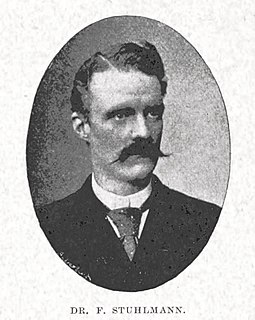
Franz Ludwig Stuhlmann was a German naturalist, zoologist and African explorer, born in Hamburg.

Warburgia is a genus of plant in family Canellaceae described as a genus in 1895. It was named for the German botanist Otto Warburg. It is native to eastern and southern Africa.
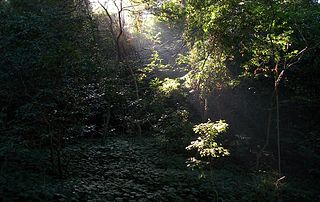
Areas of forest which grow in KwaZulu-Natal, South Africa mostly on south facing slopes in higher rainfall areas, and along the humid coastal areas. Different types of forest can be identified by their species composition which depends mostly on the altitude, latitude and substrate in which they grow. South facing slopes are favourable for the development of forest as they are more shaded, and therefore cooler and retain more moisture than the northern slopes. The extra moisture on the south slopes is not only favoured by forest trees, but also helps to prevent or subdue wildfires. Fires can also be blocked by cliff faces and rocks or boulders on these slopes, and by streams or rivers at the base of the slopes. The coastal regions are conducive to forest formation, because of high rainfall and humidity which are favoured by forest trees and also help to prevent or subdue fires. The rivers of the coastal areas are also broader than further inland, which may often prevent fires from spreading long distances, and fires generally burn uphill and therefore more often away from areas at low altitude.
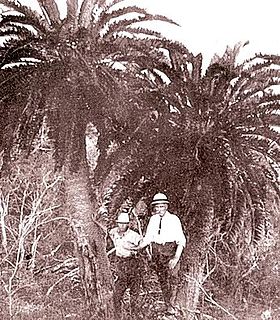
oNgoye Forest, also known as Ngoye or Ngoya Forest, is an ancient coastal scarp forest, protected by the oNgoye Forest Reserve in South Africa's KwaZulu-Natal province. The forest of almost 4,000 ha covers an extensive granite ridge that rises from 200 to 460 metres above sea level. It is found some 10 km inland, or 16 km by road, from the coastal town of Mtunzini, and adjoins smaller forest reserves on its periphery, namely Impeshulu in the west, Ezigwayini in the north, and Dengweni in the south.

The Maputaland-Pondoland-Albany Hotspot (MPA) is a biodiversity hotspot, a biogeographic region with significant levels of biodiversity, in Southern Africa. It is situated near the south-eastern coast of Africa, occupying an area between the Great Escarpment and the Indian Ocean. The area is named after Maputaland, Pondoland and Albany. It stretches from the Albany Centre of Plant Endemism in the Eastern Cape Province of South Africa, through the Pondoland Centre of Plant Endemism and KwaZulu-Natal Province, the eastern side of Eswatini and into southern Mozambique and Mpumalanga. The Maputaland Centre of Plant Endemism is contained in northern KwaZulu-Natal and southern Mozambique.
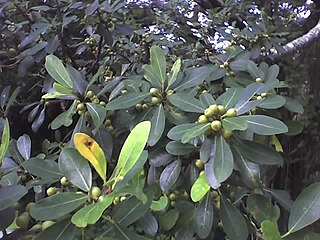
Ficus natalensis is a tree in the family Moraceae. It is commonly known as the Natal fig, or "Mutuba" to locals. These trees are distributed from north-eastern South Africa to Uganda and Kenya.

Ficus lutea is a tree in the family Moraceae. It is commonly known as the giant-leaved fig or Lagos rubbertree. These trees occur from the Eastern Cape of South Africa to Tropical Africa.

KwaZulu-Natal coastal lowland forest is a subtropical forest type that was once found almost continuously along the low-lying coastal areas of KwaZulu-Natal, South Africa. It still exists in protected areas, but much has been cleared for sugar-cane plantations and housing developments.
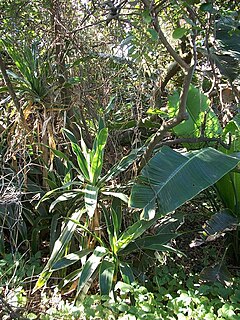
KwaZulu-Natal Dune Forest is a subtropical forest type that was once found almost continuously along the coastal dunes of KwaZulu-Natal, South Africa. This vegetation type develops in sheltered areas behind the littoral zone, where with some protection from the salt wind it may develop with canopies as tall as 30 m. It still exists in protected areas, but much has been degraded by human activity. Coastal dune forest covers approximately 1% of the land area of KwaZulu-Natal, and is a habitat type seriously threatened from human population pressure and development.

Southern African Sand Forest is a sand forest, or a subtropical forest plant community of the tropical and subtropical dry broadleaf forests biome. It grows on ancient sand dunes in northern KwaZulu-Natal and southern Mozambique. In South Africa these forests are known simply as Sand Forest, while in Mozambique they are known as Licuati Forest. The Southern African sand forest is part of the Maputaland coastal forest mosaic ecoregion.
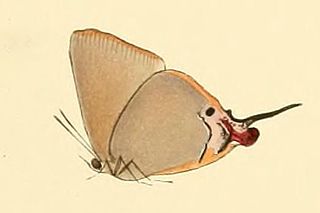
Myrina dermaptera, the lesser fig-tree blue or scarce fig-tree blue, is a butterfly of the family Lycaenidae. It is found in Sub-Saharan Africa, southern Arabia and northern Oman.

Ficus sur, with the common names Cape fig and broom cluster fig, is a widespread Afrotropical species of cauliflorous fig.
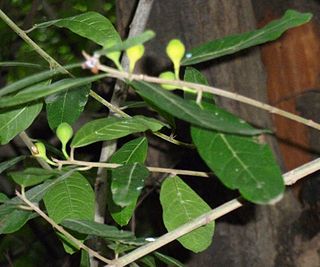
The river sandpaper fig is a fig shrub or small tree of the western and eastern Afrotropics. It is typically found around pans or flood plains, or along riparian fringes in tropical or subtropical savanna regions, but is absent from the tropical rainforest zone. Despite its regular scrambling habit it may attain a height of 7 to 10 m.

Ficus craterostoma, a species of strangler fig, is a fig shrub or tree of the Afrotropics that may grow up to 20 m tall. It is found in lowland tropical and swamp forests in the west, or in afromontane forests, including rocky situations, along Africa's eastern escarpments. The western and eastern populations may constitute separate species, as they occur at different altitudes where their ranges meet in central Africa, while they seem to have exclusive pollinating wasp species.
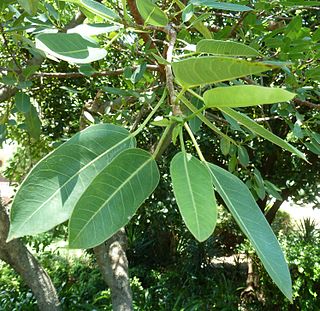
The Wonderboom is an evergreen fig species that ranges from the KwaZulu-Natal midlands northwards to tropical East Africa. It grows especially on outcrops, rocky hillsides and along cliffs fringing water courses and may rarely grow up to 10 m tall, and acquire a leafy spreading crown.

Ficus ingens, the red-leaved fig, is a fig species with an extensive range in the subtropical to dry tropical regions of Africa and southern Arabia. Despite its specific name, which means "huge", or "vast", it is usually a shrub or tree of modest proportions. It is a fig of variable habit depending on the local climate and substrate, typically a stunted subshrub on elevated rocky ridges, or potentially a large tree on warmer plains and lowlands. In 1829 the missionary Robert Moffat found a rare giant specimen, into which seventeen thatch huts of a native tribe were placed, so as to be out of reach of lions.
Allanblackia oil is a vegetable oil that comes from the seeds of trees of the genus Allanblackia. This tree can be found in the wet tropical belt of Africa. Because of its unique blend of fatty acids, the oil from Allanblackia seeds has melting properties that make it excellent to use as structuring fat in food products, e.g. margarines.


















